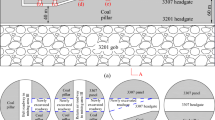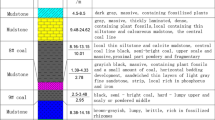Abstract
Coal pillars are formed by excavation and mining activities in an intact coal seam and play a key role in underground coal mines. Most previous investigations of pillars have mainly focused on existing coal pillar failures. However, few scholars have investigated the failure mechanisms of coal pillars during their formation process. This paper focuses on the failure of a 7 m-wide coal pillar that caused the large deformation of a tailgate in the Sijiazhuang coal mine in China. Field tests and numerical modeling were used to study the initiation, propagation, and failure of cracks within this gob-side coal pillar during its formation. Field monitoring revealed that the maximum roof-to-floor and rib-to-rib convergence reached 860 mm and 1460 mm, respectively. The coal pillar became a yield pillar with substantial fractures. A numerical model was built using UDEC Trigon logic and calibrated with laboratory tests and RQD methods. Both the natural roadway deformation and crack distribution in the coal pillar were simulated. A FISH function was used to document the propagation of shear and tensile cracks in pillars with different W/H ratios, and a damage parameter was adopted to evaluate the failure of these pillars. The results suggest that the most appropriate pillar width is 10 m. Field trials prove that a 10 m-wide coal pillar combined with optimized support measures can effectively control deformation around the tailgate.

















Similar content being viewed by others
References
Bai JB, Shen WL, Guo GL, Yu Y (2015) Roof deformation, failure characteristics, and preventive techniques of gob-side entry driving heading adjacent to the advancing working face. Rock Mech Rock Eng 48(6):2447–2458. https://doi.org/10.1007/s00603-015-0713-2
Carr F, Martin E, Gardner BH (1985) How to eliminate roof and floor failures with yield pillar. Coal Min Part II 21:44–49
Coulthard MA (1999) Applications of numerical modelling in underground mining and construction. Geotech Geol Eng 17:373–385. https://doi.org/10.1023/A:1008951216602
De Borst R, Sluys LJ, Mühlhaus HB, Pamin J (1993) Fundamental issues in finite element analysis of localization of deformation. Eng Comput 10(2):99–122. https://doi.org/10.1108/eb023897
Elmo D (2006) Evaluation of a hybrid FEM/DEM approach for determination of rock mass strength using a combination of discontinuity mapping and fracture mechanics modelling, with particular emphasis on modelling of jointed pillars. Ph.D. thesis. Camborne School of Mines, University of Exeter
Elmo D, Stead D (2010) An integrated numerical modelling–discrete fracture network approach applied to the characterisation of rock mass strength of naturally fractured pillars. Rock Mech Rock Eng 43(1):3–19. https://doi.org/10.1007/s00603-009-0027-3
Gao FQ (2013) Simulation of failure mechanisms around underground coal mine openings using discrete element modelling. PhD thesis. Simon Fraster University, Burnaby
Gao W, Ge M (2016) Stability of a coal pillar for strip mining based on an elastic-plastic analysis. Int J Rock Mech Min Sci 87:23–28. https://doi.org/10.1016/j.ijrmms.2016.05.009
Gao FQ, Kang HP (2016) Effects of pre-existing discontinuities on the residual strength of rock mass—insight from a discrete element method simulation. J Struct Geol 85:40–50. https://doi.org/10.1016/j.jsg.2016.02.010
Gao FQ, Stead D (2014) The application of a modified Voronoi logic to brittle fracture modelling at the laboratory and field scale. Int J Rock Mech Min Sci 68(68):1–14. https://doi.org/10.1016/j.ijrmms.2014.02.003
Gao FQ, Stead D, Kang HP (2015) Numerical simulation of squeezing failure in a coal mine roadway due to mining-induced stresses. Rock Mech Rock Eng 48(4):1635–1645. https://doi.org/10.1007/s00603-014-0653-2
Hill D (2005) Coal pillar design criteria for surface protection. In: Proceedings of the coal 2005 conference, 26–28 April 2005
Hoek E, Brown ET (1997) Practical estimates of rock mass strength. Int J Rock Mech Min Sci 34(8):1165–1186. https://doi.org/10.1016/S1365-1609(97)80069-X
Itasca Consulting Group Inc (2014) UDEC (universal distinct element code), version 6.0. Itasca, Minneapolis
Jaiswal A, Shrivastva BK (2009) Numerical simulation of coal pillar strength. Int J Rock Mech Min Sci 46(4):779–788. https://doi.org/10.1016/j.ijrmms.2008.11.003
Kang HP, Lin J, Yan LX, Zhang X, Wu YZ (2009) Study on characteristics of underground in-situ distribution in Shanxi coal mining fields. Chin J Geophys 52(7):1782–1792
Kazerani T, Zhao J (2010) Micromechanical parameters in bonded particle method for modelling of brittle material failure. Int J Numer Anal Methods Geomech 34(18):1877–1895. https://doi.org/10.1002/nag.884
Li WF, Bai JB, Peng SS, Wang XY, Xu Y (2015) Numerical modeling for yield pillar design: a case study. Rock Mech Rock Eng 48(1):305–318. https://doi.org/10.1007/s00603-013-0539-8
Lisjak A, Grasselli G (2014) A review of discrete modeling techniques for fracturing processes in discontinuous rock masses. J Rock Mech Geotech Eng 6(4):301–314. https://doi.org/10.1016/j.jrmge.2013.12.007
Lorig LJ, Cundall PA (1989) Modeling of reinforced concrete using the distinct element method. In: Fracture of concrete and rock. Springer, New York, pp 276–287
Maleki H (1992) In situ pillar strength and failure mechanisms for US coal seams. In: Proceedings of the workshop on coal pillar mechanics and design. US States Bureau of Mines, Pittsburgh, IC-9315, pp 73–78
Mayer JM, Stead D (2017) Exploration into the causes of uncertainty in UDEC grain boundary models. Comput Geotech 82:110–123. https://doi.org/10.1016/j.compgeo.2016.10.003
Mortazavi A, Hassani FP, Shabani M (2009) A numerical investigation of rock pillar failure mechanism in underground openings. Comput Geotech 36(5):691–697. https://doi.org/10.1016/j.compgeo.2008.11.004
Peng SS (2006) Longwall mining, 2nd edn. Peng SS Publisher, Morgantown
Pine RJ, Coggan JS, Flynn ZN, Elmo D (2006) The development of a new numerical modelling approach for naturally fractured rock masses. Rock Mech Rock Eng 39(5):395–419. https://doi.org/10.1007/s00603-006-0083-X
Poulsen BA (2010) Coal pillar load calculation by pressure arch theory and near field extraction ratio. Int J Rock Mech Min Sci 47(7):1158–1165. https://doi.org/10.1016/j.ijrmms.2010.06.011
Salamon MDG (1970) Stability, instability and design of pillar workings. Int J Rock Mech Min Sci Geomech 7(6):613–631. https://doi.org/10.1016/0148-9062(70)90022-7
Salamon MDG, Munro AH (1967) A Study of the strength of coal pillars. J S Afr Inst Metall 68:55–67
Singh M, Seshagiri Rao K (2005) Empirical methods to estimate the strength of jointed rock masses. Eng Geol 77:127–137. https://doi.org/10.1016/j.enggeo.2004.09.001
Wang SL, Hao SP, Chen Y, Bai JB, Wang XY, Xu Y (2016a) Numerical investigation of coal pillar failure under simultaneous static and dynamic loading. Int J Rock Mech Min Sci 84:59–68. https://doi.org/10.1016/j.ijrmms.2016.01.017
Wang WJ, Yuan C, Yu WJ, Wu H, Peng WQ, Peng G, Liu XS, Dong EY (2016b) Stability control method of surrounding rock in deep roadway with large deformation. J China Coal Soc 41(12):2921–2931 2016. 1115
Yu B, Zhang ZY, Kuang TJ, Liu JR (2016) Stress changes and deformation monitoring of longwall coal pillars located in weak ground. Rock Mech Rock Eng 49(8):3293–3305. https://doi.org/10.1007/s00603-016-0970-8
Zhang L, Einstein HH (2004) Using RQD to estimate the deformation modulus of rock masses. Int J Rock Mech Min Sci 41(2):337–341. https://doi.org/10.1016/S1365-1609(03)00100-X
Zhang GC, He FL, Jia HG, Lai YH (2017) Analysis of gateroad stability in relation to yield pillar size: a case study. Rock Mech Rock Eng 50:1263–1278. https://doi.org/10.1007/s00603-016-1155-1
Acknowledgements
This research has been supported by the Fundamental Research Funds for the Central Universities (2017XKZD06). The authors thank Sijiazhuang coal mine for their support during the field test. Also, this article benefited from valuable comments and suggestions by co-editors and other anonymous reviewers.
Author information
Authors and Affiliations
Corresponding author
Additional information
Publisher’s Note
Springer Nature remains neutral with regard to jurisdictional claims in published maps and institutional affiliations.
Rights and permissions
About this article
Cite this article
Wu, Wd., Bai, Jb., Wang, Xy. et al. Numerical Study of Failure Mechanisms and Control Techniques for a Gob-Side Yield Pillar in the Sijiazhuang Coal Mine, China. Rock Mech Rock Eng 52, 1231–1245 (2019). https://doi.org/10.1007/s00603-018-1654-3
Received:
Accepted:
Published:
Issue Date:
DOI: https://doi.org/10.1007/s00603-018-1654-3




